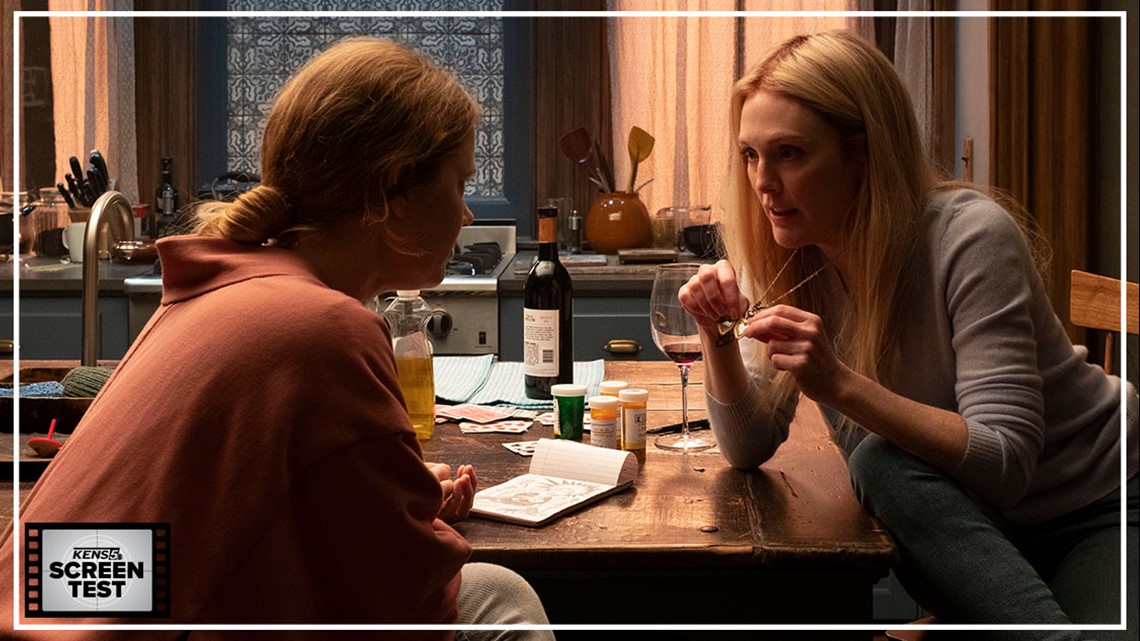Here’s an interesting experiment: Watch and compare both trailers promoting “The Woman in the Window” – one of them released in late 2019, the other just a few weeks ago – to see if Hollywood knows what kind of movie it has in Joe Wright’s latest. Sure, both provide plot basics before escalating into something exciting and frenetic. The 2019 teaser – released by 20th Century Studios when “Woman in the Window” was still slated for release the following spring – suggests that “everyone is a suspect” and “everything is a clue.” The April trailer released by Netflix – which acquired the project after its theatrical debut was aborted – provides loglines for an experience in which deepest fears are faced and darkest truths revealed.
The marketingspeak could apply to any things-aren’t-what-they-seem chiller, but they’re particularly appropriate for this disjointed movie which (befitting its clear homages to Alfred Hitchcock) assumes the identities of various others for no discernible reason other than it simply can. To watch it is to be perplexed about its aims, and to wonder whether it’s observing those aims through the blurred vision of crafting something intriguing on a purely technical level, which I’d wager it’s accomplished.
I’d also wager the starpower of the film – the Amy Adams, Gary Oldman, Julianne Moore of it all – will be enough for most Netflixxers to find their time worthwhile. Regardless, from a narrative standpoint “The Woman in the (Rear) Window” is a blunt edge in need of sharpening. It slices neatly along genre mechanics – the potent threat of something sinister at play beyond our understanding – before suddenly striking the bone of utmost sincerity, as though trying to reach a middle ground for the sake of reviving the long-shot awards potential it once had. It makes a solid case for keeping the kind of domestic noir where revelations are revealed with the roar of a thunderclap alive, but is less harmonious as an individual melody in that very particular storytelling rhythm.
“Woman in the Window” comes our way – finally, 19 months after it was originally intended to bow – from “Anna Karenina” and “Atonement” director Joe Wright. Based on the novel written by A.J. Finn (whose own literary career drama arguably makes for a more intriguing story than this), the film follows the suspicions of Anna Fox (Amy Adams), a child therapist and agoraphobic who spends her days pacing and watching old movies in her dimly lit home following a traumatic incident the screenplay initially keeps us guessing about. It feigns interest in that deeply rooted trauma – at times convincingly so – but in Wright’s hands, “The Woman in the Window” is clearly enticed by it as merely a narrative entry into the relationship between Anna’s psychological facility and her unwitting investment in the wealthy family that’s just moved in across the street, the Russells. Besides her therapist (Tracy Letts) and the amiable, yet distanced landlord who lives in the basement, David (Wyatt Russell, a regular Joe Shmoe here compared to his portrayal of Captain America 2.0 in “The Falcon and the Winter Soldier”), Anna isn’t going out of her way to talk to many people these days. Yet she finds herself sympathizing with young Ethan Russell (Fred Hechinger) and mother Jane (Julianne Moore) when they show up to her home on separate occasions, willing to open herself up so long as she’s on her territory.
Speaking of Anna’s home, this movie presents Wright following up 2017’s “The Darkest Hour” with what could just as well be called “The Darkest House.” You’ll want to make sure all blinds are close and hallway lights flipped off when pressing play, if not to mimic the experience of watching as was intended once upon a non-pandemic time, then at least to soak in the pulpy visual choreography and literal trappings of the cavernous setting it almost entirely takes place in (even the world outside looks to be stuck in perpetual night). Frequent Coen Bros. collaborator Bruno Delbonnel’s work behind the camera makes for some of the most dizzyingly impactful touches in an otherwise low-wattage thriller, and the nightmarish geography of its protagonist’s home and unreliable perspective – are they the same thing? – is reminiscent of a swirling ink-blot cousin to the labyrinthian setting of Florian Zeller’s “The Father,” another movie about shifty cinematic lenses that surfaced in my mind on more than one occasion while watching this one.


The cinematography is a standout element, and its leading woman is another. While recent projects have done less to tap into it, Adams – one of our most reliable working performers – is most masterful when playing characters defined by emotional compromises and cerebral pursuits of the upper hand. It suits her well for Anna, who we sense as constantly being on alert for herself and others against would-be antagonists, including the abusive Alistair Russell (Gary Oldman, a far cry from the inspiring political leader he portrayed in his latest collaboration with Wright). And as “The Woman in the Window” takes its initial turns for the suspenseful, initiated when Anna observes a bloody confrontation across the street, Adams organically shifts the character’s caution into a gear of obsessiveness as her perspective comes under question.
And ours, as well. Because the movie is told through Anna’s unstable point of view – a point of view turned more volatile every time she downs her medications with a swig of wine – it becomes one of those stories where the only thing the audience can be sure of is that they’re not sure of anything.
Well, that isn’t entirely accurate. We can be sure about Anna’s good intentions, about her frustrated insistence that she knows what she saw before and can’t make heads or tails of what she sees now. We can be sure Wright’s experience with formalistic invention will be put to good use here as he toys with lighting and spatial geography to conjure up a whirlpool momentum. And we can be sure that “Woman in the Window” comes mighty close to exploiting mental illness, using it as a cushion to soften blows against the guardrails of its twisty screenplay whose surprises tend to land with more confusion than dark satisfaction. This is a mostly competent film, which makes its flaws more difficult to pinpoint and also illuminates its biggest: It simply isn’t all that memorable as a whole.
We might chalk that up to impossible levels of expectation unfairly set upon movies which go through extensive reshoots as this one reportedly did, but I’m inclined to acknowledge a nagging feeling I had that the methods the movie undertakes to disorient its audience – compressions of time, confusing voiceover overlaps – backfires on the movie itself. At a certain point, we’re left waiting, a little too patiently and a little too calmly, for loose ends to tie themselves up and perpetrators to step out from the shadows instead of being terrified by the possibilities of who they may be. The movie’s mystery succeeds in putting us near the cliff’s edge, just not quite close enough to where we’re tempted to peer over into the terrifying drop.
"The Woman in the Window" is rated R for violence and language. It's available to stream on Netflix Friday.
Starring: Amy Adams, Gary Oldman, Fred Hechinger, Wyatt Russell
Directed by Joe Wright
2021
MORE REVIEWS:
- 'Wrath of Man' Review: Guy Ritchie underestimates his own star and story in needlessly messy crime thriller
- ‘Undergods’ Review: An ill-shapen diorama about the ills of capitalism
- ‘The Paper Tigers’ Review: Martial arts flick struggles to balance heart and humor amid flecks of personality
- ‘The Mitchells vs. the Machines’ Review: A deliriously fun road trip to the end of the world
- ‘Nomadland’ Review: Frances McDormand ventures west in a lament and tender celebration of America’s final frontiers
- ‘Together Together’ Review: Patti Harrison submits a star-making turn opposite Ed Helms in a different kind of rom-com
- ‘In the Earth’ Review: Ben Wheatley’s eco-horror tale taps into pandemic-era anxieties at the most twisted of moments

